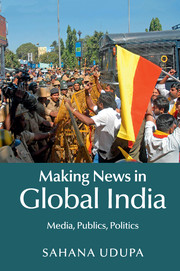Book contents
- Making News in Global India
- Making News in Global India
- Copyright page
- Contents
- List of figures
- Book part
- Notes on translation, pseudonyms and abbreviations
- Glossary
- Introduction
- 1 Regimes of desire
- 2 Democracy by default
- 3 The difference machine
- 4 KannadaJāgaṭe
- 5 ‘Journalists are pimps’
- Conclusion
- Notes
- Bibliography
- Index
- References
Bibliography
Published online by Cambridge University Press: 05 June 2015
- Making News in Global India
- Making News in Global India
- Copyright page
- Contents
- List of figures
- Book part
- Notes on translation, pseudonyms and abbreviations
- Glossary
- Introduction
- 1 Regimes of desire
- 2 Democracy by default
- 3 The difference machine
- 4 KannadaJāgaṭe
- 5 ‘Journalists are pimps’
- Conclusion
- Notes
- Bibliography
- Index
- References
- Type
- Chapter
- Information
- Making News in Global IndiaMedia, Publics, Politics, pp. 247 - 269Publisher: Cambridge University PressPrint publication year: 2015



